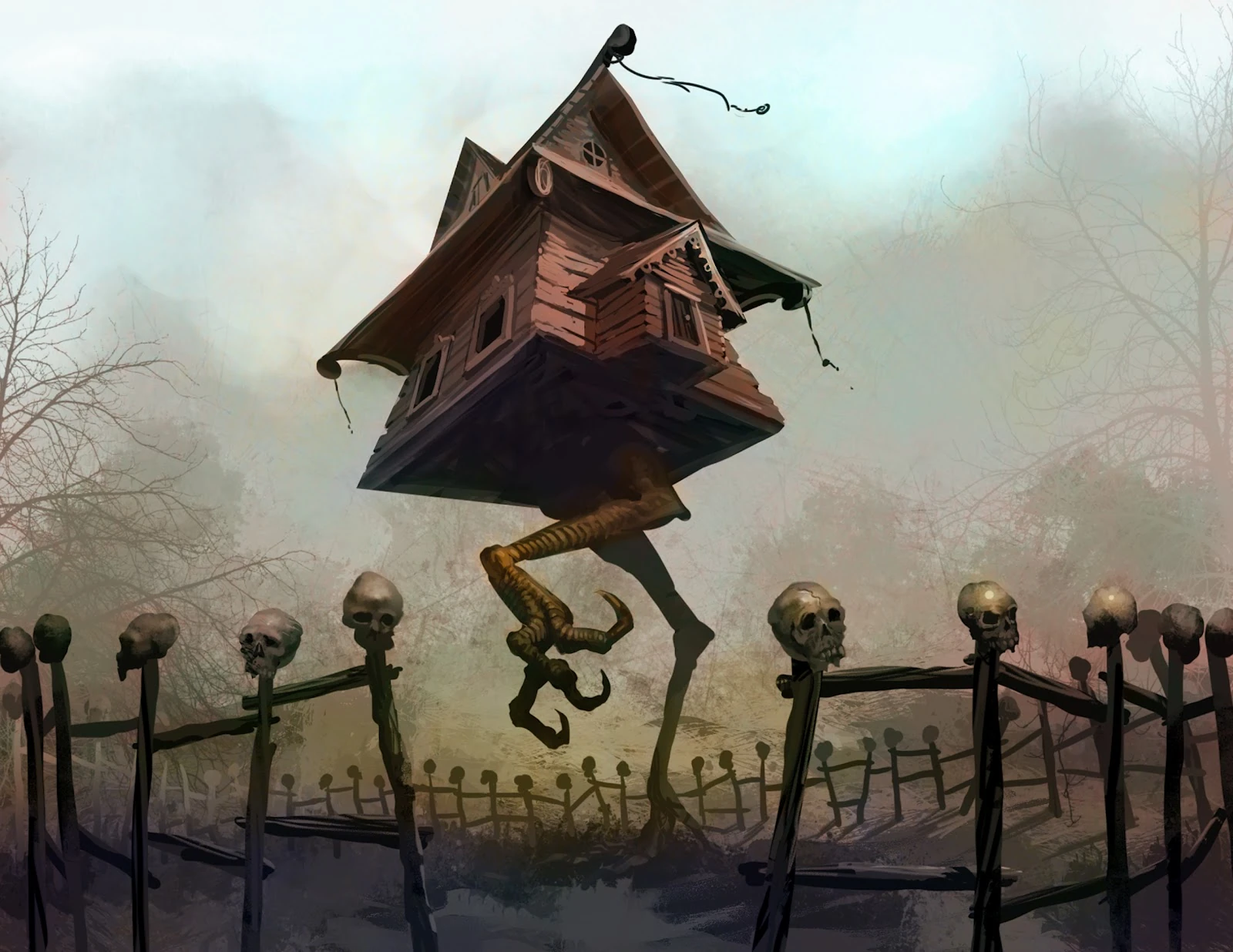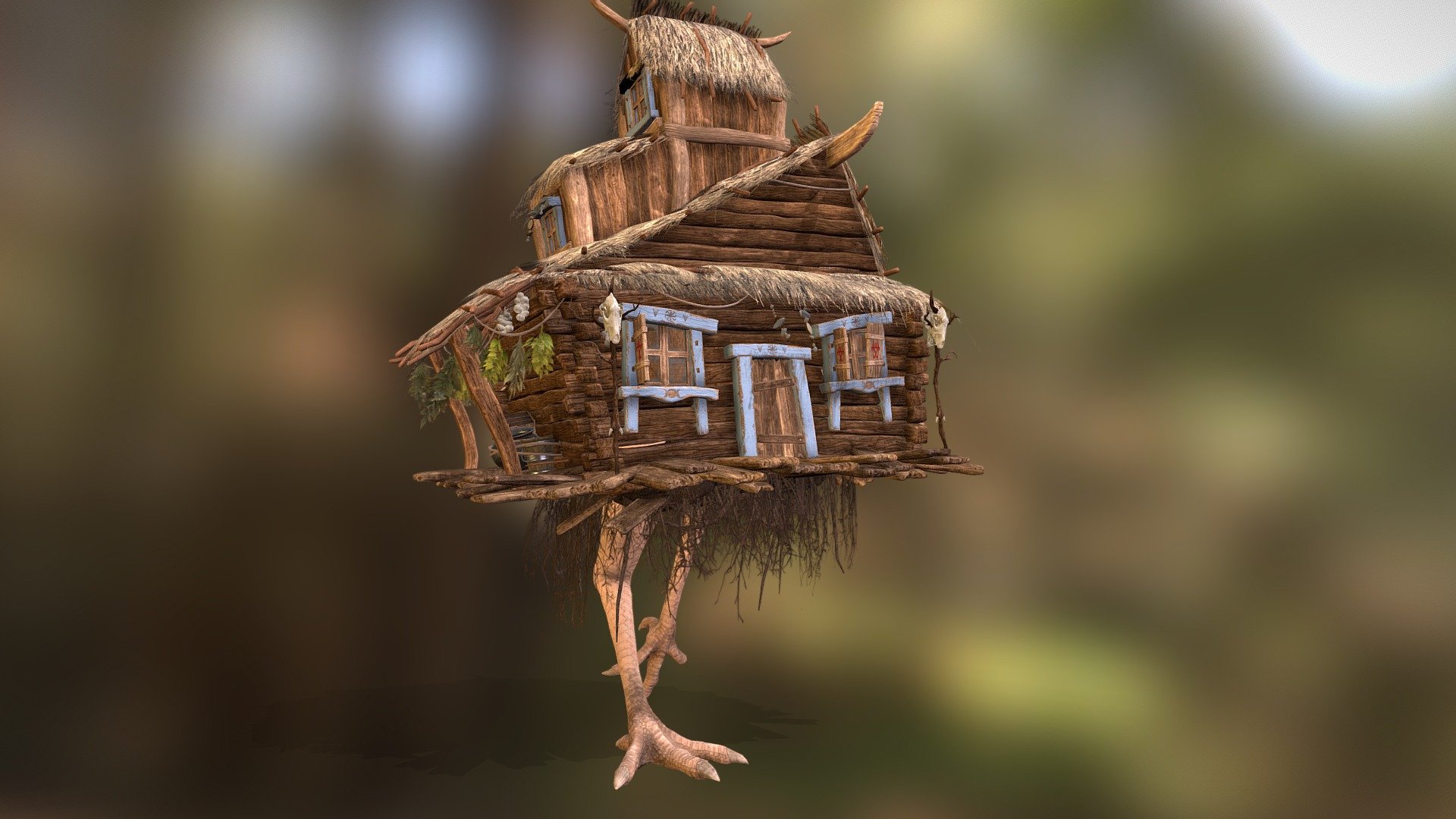
baba yaga Tumblr Baba yaga, Baba yaga house, Russian folk art
Category: Arts & Culture Also spelled: Baba Jaga See all related content → Baba Yaga Baba Yaga, illustration by Ivan Bilibin from Narodnyye russkiye skazki ("Russian Popular Fairy Tales"). Baba Yaga, in Slavic folklore, an ogress who steals, cooks, and eats her victims, usually children.

"Baba Yaga Houses" by cylindric Redbubble
One of the most beloved (and feared) figures in Russian and East Slavic folklore, Baba Yaga is more than just a witch. She's a rumored cannibal who lives in a strange rotating house and flies.

Pin by Faerie Granma on Secret Gardens Baba yaga, Cabin exterior
Poor Natasha! She would run into the backyard and to the shed to hide. She would wet the small crust with her tears and eat it, all alone. Then the stepmother would yell that she must come back in the house, right away! The dishes from dinner needed washing, and the floor must be swept clean till it shone.

Baba Yaga's House By Walker Babington from facebook Baba yaga house
Baba Yaga is one of the most impressive figures in Russian folklore. An old woman with witch-like powers, she flies in a huge mortar, using the the pestle as a rudder, or sometimes on a broomstick. Sometimes she kidnaps children — or, lost in the woods or great field, they come upon her hut and never return home.

Baba Yaga's House Halloween Love Baba yaga house, Baba yaga
World History Encyclopedia, 27 Aug 2021. Web. 03 Jan 2024. An image portraying Baba Yaga's hut. Baba Yaga was said to live in a hut standing on chicken's legs. In Slavic folklore, Baba Yaga was a witch who often preys.

Baba Yaga's House 8x10 fine art print witch art fairy Etsy Baba Yaga
This is the section featuring his translation of Vasilissa the Fair, but it also includes different descriptions of Baba Yaga's house—the familiar, shifting, moving one on chicken legs, and.

Baba Yaga House The Everything Wikia Fandom
The Baba Yaga House is a Domus Mactibilis from the Russian legend, The Baba Yaga. Which also appears as a structural golem in the Encyclopedia of Monsters on the Monster House Website. The legend is about a Russian Witch from the Russian Woods. She is scary, ugly, and eats children. She lives in.

ArtStation Baba Yaga's House, Cyril Chevtchouk Fantasy house, Baba
But in place of dozens of nameless, black-clad, pointy-hatted women standing over glowing green, bubbling cauldrons, Baba Yaga is the character in Russian folklore that keeps characters out of strange woods. While her description varies from story to story, Baba Yaga is typically described as an old, bony woman in raggedy clothes.

Baba yaga, Baba yaga house, House cartoon
8 Selfish Witch Leaves Away From The Civilization. A Slavic witch, or Baba Yaga, rejects what society expects of her. She lives away from civilization in the woods and even rejects society herself. A Slavic witch serves as a reminder to those who wander into the woods. If you go too deep into the woods, Baba Yaga will eat you.

Baba Yaga House Baba Yaga's House Posters and Prints Posterlounge
Baba Yaga (Baba Jaga) is a witch or ogress from Slavic folklore who lives in a magical hut in the forest and either helps, imprisons, or eats people (usually children). She is among the most famous figures from Slavic folklore as guardian of the fountains of the waters of life and is sometimes seen as embodying female empowerment and independence.

Luke GroundWalker Illustrations House of the Baba Yaga
In the thrice tenth kingdom beyond the thrice nine lands flourishes a vivid world full of talking wolves, shimmering firebirds, immortal soldiers, and a truly improbable number of boys named Ivan and girls named Vasilisa.

Baba Yaga's House 3D model by katarzynaszemla [d8780d1] Sketchfab
The Baba Yaga stories were originally passed down orally. The first written story is reported to be Russian Grammar by Mikhail W. Lomonosov. The Baba Yaga House. Baba Yaga lives in a hut on chicken legs that run fast to move the hut. The hut's windows are sentient eyes and human bones, including skulls, decorate the top of the fence around.

ArtStation Baba Yaga’s House
Baba Yaga is an enigmatic or ambiguous character from Slavic folklore (or one of a trio of sisters of the same name) who has two opposite roles. In some motifs she is described as a repulsive or ferocious-looking old woman who fries and eats children, while in others she is a nice old woman, who helps out the hero. [1]

baba yaga house russia ile ilgili görsel sonucu Miniature houses
Victor Vasentsov. What Does Baba Yaga Mean? The first written reference to her was in 1755 in Mikhail W. Lomonosov's Russian Grammar. Baba has been translated as old woman, hag, or grandmother, depending on which Slavic language is being referenced. Yaga or Iaga has no definitive scholarly consensus.

Baba Yaga House! r/StableDiffusion
Lastly, the maiden is to go to her aunt-in-law, Baba Yaga's house and ask for weaving supplies. On the way there, the maiden ties a ribbon around a birch tree, feeds geese and chickens with peas, smears the hinge of a door with butter and gives bread to a dog and a cat. Baba Yaga welcomes her, goes to another room to sharpen her teeth, and.

Baba Yaga's hut by madness616 Сказки, Баба яга, Лесные существа
Baba Yaga's house, which sits in the darkest corner of the woods, stands atop chicken legs. A rooster head sometimes pokes up from the roof. And the witch protects her hut with a fence built from human bones. Like many other legendary witches, Baba Yaga enjoys roasting and eating her victims in her house, where she keeps an enormous oven.